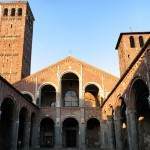 Founded in 379 by Saint Ambrose himself, protector of Milan, as the "Basilica Martyrum" (Basilica of the martyrs), since it housed the remains of Saints Gervasio and Protasio. The Bishop himself was buried there after his death, on Easter Day in the year 397 AD. The original church was repeatedly renovated over the centuries, modifying its initial austere appearance with three naves, as a new presbytery and new apse followed the construction of a second bell tower by the tenth century. In 1126, a collapse of the building obliged large scale interventions and adaptations that continued on in later centuries, until the nineteenth century "restoration" work which, in an attempt to bring back the church's appearance before the collapse of 1196, ultimately had a significant effect on the Basilica's final representation.
Founded in 379 by Saint Ambrose himself, protector of Milan, as the "Basilica Martyrum" (Basilica of the martyrs), since it housed the remains of Saints Gervasio and Protasio. The Bishop himself was buried there after his death, on Easter Day in the year 397 AD. The original church was repeatedly renovated over the centuries, modifying its initial austere appearance with three naves, as a new presbytery and new apse followed the construction of a second bell tower by the tenth century. In 1126, a collapse of the building obliged large scale interventions and adaptations that continued on in later centuries, until the nineteenth century "restoration" work which, in an attempt to bring back the church's appearance before the collapse of 1196, ultimately had a significant effect on the Basilica's final representation.